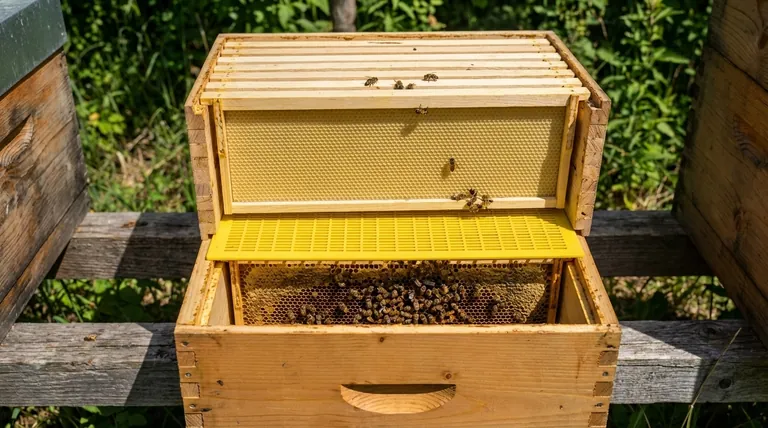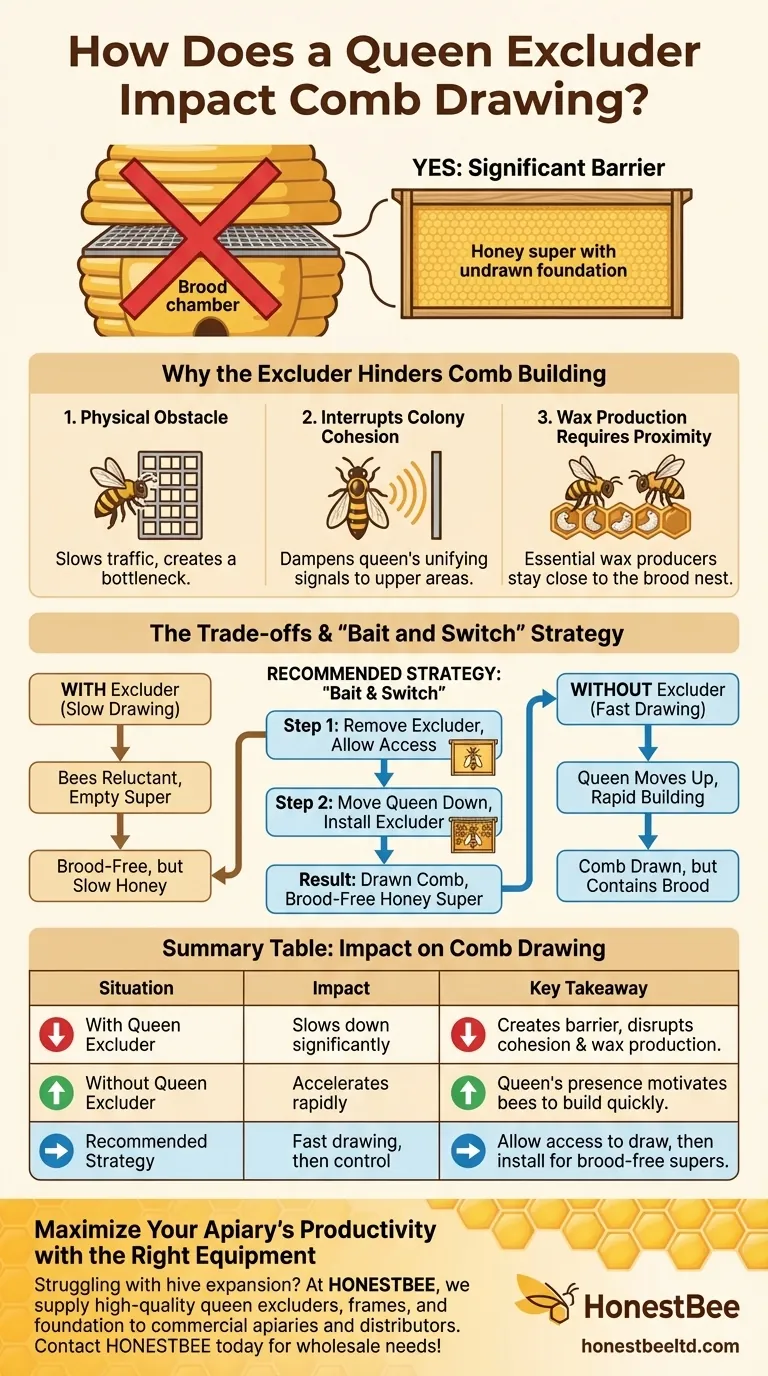In short, yes. A queen excluder significantly inhibits and slows down the process of bees drawing out new comb on foundation. It acts as a major barrier that disrupts the natural upward expansion and work-flow of the colony.
The core issue is that a queen excluder creates an artificial separation within the hive. Bees are reluctant to invest significant resources—like building new wax comb—in a space that feels disconnected from the queen and the central brood nest.

The Role of the Queen Excluder
What It Is, and What It Does
A queen excluder is a simple grid, typically made of metal or plastic. The openings are engineered to be large enough for worker bees to pass through but too small for the larger queen bee.
Its sole purpose is to confine the queen to the lower hive bodies, known as the brood chamber. This ensures she only lays eggs there, leaving the upper boxes, or "honey supers," exclusively for honey storage.
The Goal: A Brood-Free Honey Super
By keeping the queen out of the honey supers, beekeepers can harvest frames that contain only pure honey. This avoids the complication of having developing bees (brood) mixed in with the honey crop, simplifying the extraction process.
Why the Excluder Hinders Comb Building
It's a Physical Obstacle
While worker bees can squeeze through the excluder, it is not a seamless passage. The grid slows traffic, creating a bottleneck that discourages the constant, free-flowing movement required for a major construction project like drawing comb.
It Interrupts Colony Cohesion
A bee colony functions as a single "superorganism." The queen's pheromones are a critical signal that unifies the hive. An excluder can dampen the spread of these signals, making the super above feel like a distant, less important territory.
Bees are far more motivated to build and expand in areas they perceive as the core of the hive. The space above an excluder often fails this test.
Wax Production Requires Proximity to the Brood Nest
The primary wax producers in a hive are younger worker bees. These bees tend to stay close to the brood nest where they also care for larvae. An excluder discourages these essential wax-producers from moving up into an empty super of foundation.
Understanding the Trade-offs
The Risk of No Excluder: The Queen Moves Up
If you add a new super of foundation without an excluder, there is a high probability the queen will move up and begin laying eggs in the newly drawn comb.
Why This Can Be a Good Thing (Temporarily)
The queen's presence in the new super is the strongest possible signal to the workers to get busy. They will draw out the foundation with incredible speed to accommodate her egg-laying.
While this means the first use of the comb will be for brood, not honey, it solves the much harder problem of getting the comb built in the first place. Once the brood hatches, the cells are cleaned and will be backfilled with honey.
The "Bait and Switch" Strategy
The most effective method is to use the queen's instincts to your advantage. Allow her access to the new super to encourage rapid comb building. Once the frames are drawn out, you can then move the queen back down and place the excluder between the brood box and the now-drawn honey super.
The Correct Sequence for Your Goal
To get foundation drawn efficiently, you must work with the bees' natural instincts, not against them.
- If your primary focus is drawing new comb as quickly as possible: Do not use a queen excluder until the foundation is almost entirely drawn out.
- If your primary focus is guaranteeing a brood-free honey super from the start: You must accept a much slower comb-drawing process and may need to "bait" the bees upward by placing a frame of already-drawn comb in the center of the new super.
- For the most practical and widely used approach: Remove the excluder to get the comb built, then install it once the construction job is complete to reclaim the box for honey.
Understanding this principle allows you to manage your hive's expansion in the most effective way possible.
Summary Table:
| Situation | Impact on Comb Drawing | Key Takeaway |
|---|---|---|
| With Queen Excluder | Slows down significantly | Creates a barrier, disrupting colony cohesion and wax production. |
| Without Queen Excluder | Accelerates rapidly | Queen's presence motivates bees to build comb quickly. |
| Recommended Strategy | Fast drawing, then control | Allow queen access to draw comb, then install excluder to keep supers brood-free. |
Maximize Your Apiary's Productivity with the Right Equipment
Struggling with slow comb drawing or managing hive expansion? The right tools are crucial for efficient beekeeping. At HONESTBEE, we specialize in supplying high-quality, durable beekeeping supplies and equipment—including queen excluders, frames, and foundation—to commercial apiaries and beekeeping equipment distributors.
Our wholesale-focused operations ensure you get the reliable gear you need to work with your bees' instincts, not against them. Let us help you optimize your honey production and hive health.
Contact HONESTBEE today to discuss your wholesale needs and elevate your beekeeping operation!
Visual Guide

Related Products
- Professional Plastic Queen Excluder for Modern Beekeeping
- Wooden Queen Bee Excluder for Beekeeping
- Premium Wood Framed Metal Wire Queen Bee Excluder
- Metal Queen Bee Excluder for Beekeeping
- High Performance Plastic Queen Excluder for Beekeeping and Apiary Management
People Also Ask
- What are the pros of using a queen excluder? Boost Hive Control & Honey Quality
- What are the main advantages of using a queen excluder in beekeeping? Simplify Hive Management & Harvest
- What is the role of a queen excluder when adding a super? Ensure Brood-Free Honey Harvests
- What is the primary function of a queen excluder in beekeeping? Control Hive Layout for Efficient Honey Harvesting
- What is the purpose of a queen excluder when adding a super? Streamline Your Honey Harvest



















